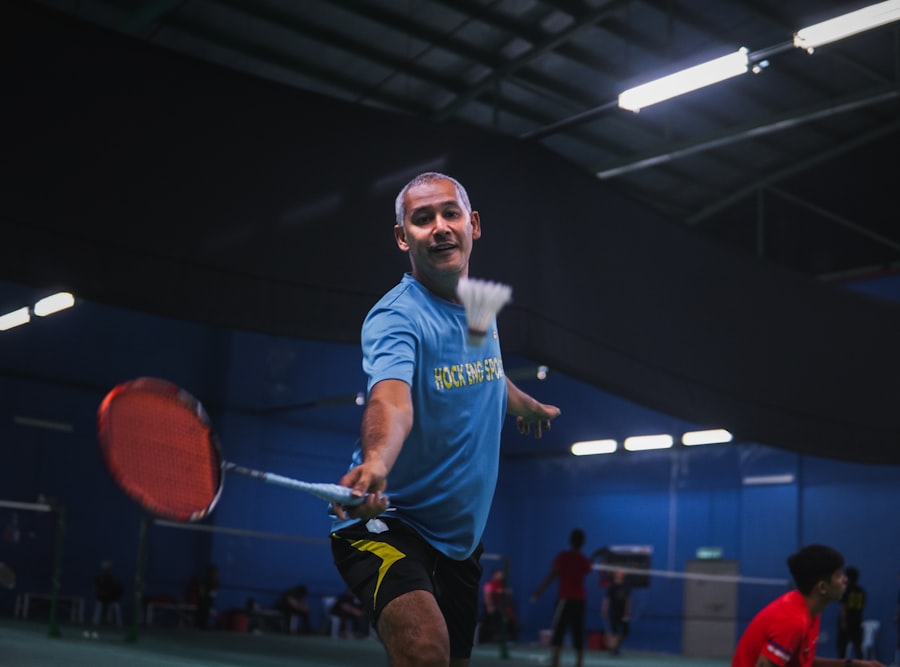Mastering the Basics of Badminton: A Beginner’s Guide
Description
Badminton is a sport steeped in tradition and governed by a set of rules that ensure fair play and competitive integrity. The game can be played in singles or doubles formats, with each player or team aiming to score points by landing the shuttlecock in the opponent’s court. The scoring system used in modern badminton is known as the rally scoring system, which was adopted in 2001.
Under this system, a point is awarded on every serve, regardless of which side served. Matches are typically played to 21 points, and a player or team must win by at least a two-point margin. If the score reaches 20-20, a player or team must win by two points, leading to potential scenarios where the score can extend to 30-29.
Understanding the rules also involves familiarizing oneself with the dimensions of the court and the specific areas designated for singles and doubles play. The badminton court is rectangular, measuring 13.4 meters long and 6.1 meters wide for doubles, while the width narrows to 5.18 meters for singles matches. The net, which stands at 1.55 meters high at the center, divides the court into two equal halves.
Players must serve from behind the service line and aim to land the shuttlecock within the opponent’s service box. Additionally, players must adhere to specific rules regarding faults, such as hitting the shuttlecock out of bounds or failing to clear the net during a serve. Familiarity with these regulations is crucial for any player aspiring to compete effectively.
Key Takeaways
- Understanding the rules and scoring system is essential for playing badminton competitively and effectively.
- Mastering essential badminton strokes such as the clear, drop shot, smash, and drive is crucial for success on the court.
- Learning proper footwork and movement techniques is key to being able to move quickly and efficiently around the badminton court.
- Selecting the right badminton equipment, including rackets, shuttlecocks, and shoes, can greatly impact your performance.
- Developing a strategy for singles and doubles play can give you a competitive edge and improve your overall game.
Mastering the Essential Badminton Strokes
To excel in badminton, players must develop proficiency in a variety of strokes that are fundamental to gameplay. The primary strokes include the forehand and backhand drives, clears, drops, smashes, and net shots. Each stroke serves a distinct purpose and can be employed strategically depending on the situation during a match.
For instance, the forehand clear is an essential stroke used to send the shuttlecock high and deep into the opponent’s court, allowing players to regain their position and prepare for the next shot. Mastering this stroke requires not only proper grip and technique but also an understanding of timing and placement. The backhand stroke is equally important, as it allows players to respond effectively to shots directed towards their non-dominant side.
A well-executed backhand can surprise opponents and create opportunities for offensive plays. The drop shot, characterized by its delicate touch, is used to catch opponents off guard by landing the shuttlecock just over the net. In contrast, the smash is a powerful attacking stroke aimed at overwhelming opponents with speed and force.
Players must practice these strokes repeatedly to develop muscle memory and ensure consistency during matches. Additionally, incorporating variations in spin and angle can further enhance a player’s ability to control the game.
Learning the Proper Footwork and Movement Techniques

Footwork is often regarded as one of the most critical aspects of badminton, as it directly influences a player’s ability to reach the shuttlecock effectively and execute strokes with precision. Good footwork allows players to maintain balance while moving quickly around the court, enabling them to respond to their opponent’s shots efficiently. The basic footwork patterns include lunges, side steps, and quick pivots, all of which are essential for navigating the court’s dimensions.
A common technique employed by players is the “split step,” which involves a small jump just before an opponent strikes the shuttlecock. This movement prepares players to move in any direction quickly, enhancing their reaction time. Practicing footwork drills can significantly improve agility and coordination on the court.
For example, players can set up cones or markers to simulate various shot placements and practice moving towards them while maintaining proper form. Developing these movement techniques not only enhances performance but also reduces the risk of injury by promoting proper body mechanics.
Selecting the Right Badminton Equipment
| Equipment | Criteria | Importance |
|---|---|---|
| Racket | Weight, grip size, flexibility | High |
| Shuttlecock | Feather or plastic, speed rating | High |
| Shoes | Grip, cushioning, support | Medium |
| Grip tape | Material, thickness, durability | Low |
Choosing the right equipment is crucial for any badminton player looking to enhance their performance on the court. The most important piece of equipment is undoubtedly the badminton racket, which comes in various weights, balances, and materials.
In addition to rackets, selecting appropriate shuttlecocks is essential for optimal gameplay. Feather shuttlecocks are preferred in professional settings due to their flight characteristics and durability; however, nylon shuttlecocks are often used for recreational play due to their affordability and resilience. Players should also invest in quality footwear designed specifically for badminton, as proper shoes provide necessary support and traction on indoor courts.
Lastly, wearing comfortable athletic apparel that allows for freedom of movement can significantly impact performance during matches.
Developing a Strategy for Singles and Doubles Play
Strategic thinking is vital in badminton, as players must adapt their tactics based on whether they are competing in singles or doubles matches. In singles play, players often focus on controlling the center of the court and utilizing a mix of offensive and defensive shots to outmaneuver their opponent. A common strategy involves varying shot placement to keep opponents guessing while capitalizing on any weaknesses observed during play.
In doubles matches, teamwork becomes paramount. Players must communicate effectively with their partner to establish roles on the court—typically one player takes on a more aggressive role at the net while the other covers the backcourt. Effective positioning is crucial; players should aim to create angles that make it difficult for opponents to return shots while also being prepared for quick exchanges at the net.
Developing a cohesive strategy that leverages both players’ strengths can lead to significant advantages during matches.
Improving Your Serve and Return Techniques

The serve is one of the most critical aspects of badminton gameplay, as it sets the tone for each rally. A well-executed serve can put immediate pressure on opponents while providing an opportunity for offensive play right from the start. There are several types of serves in badminton: high serves, low serves, flick serves, and drive serves, each serving different strategic purposes.
High serves are typically used in singles play to push opponents back toward the baseline, while low serves are more common in doubles play to force opponents into a quick response at the net. Equally important is mastering return techniques after an opponent serves. Players should focus on reading their opponent’s body language and racket position to anticipate where they will place their serve.
A strong return can shift momentum in favor of the returning player or team; therefore, practicing various return strategies—such as aggressive drives or delicate drops—can enhance overall performance during matches.
Incorporating Fitness and Conditioning into Your Training
Physical fitness plays an integral role in badminton performance, as it directly impacts agility, endurance, strength, and overall athleticism on the court. Incorporating fitness training into regular practice routines can help players develop these essential attributes. Cardiovascular conditioning is particularly important; activities such as running or cycling can improve stamina, allowing players to maintain high levels of performance throughout long matches.
Strength training should also be part of a comprehensive training regimen. Exercises targeting core muscles enhance stability during play while upper body strength contributes to powerful strokes. Plyometric exercises can improve explosive movements necessary for quick footwork and powerful smashes.
Flexibility training through stretching or yoga can prevent injuries and improve range of motion—both critical factors in executing complex movements during matches.
Finding a Badminton Community and Seeking Coaching Support
Engaging with a badminton community can significantly enhance a player’s development journey by providing opportunities for practice, competition, and social interaction with fellow enthusiasts. Local clubs often host regular training sessions and tournaments that allow players of all skill levels to participate and improve their game through friendly competition. Joining such communities fosters camaraderie among players while also providing access to valuable resources such as coaching clinics or workshops.
Seeking coaching support can further accelerate skill development by providing personalized feedback and structured training plans tailored to individual needs. Coaches can identify areas for improvement that players may overlook themselves and offer targeted drills designed to address specific weaknesses. Whether through private lessons or group sessions at local clubs, working with experienced coaches can provide insights into advanced techniques and strategies that elevate a player’s game to new heights.
By understanding these various aspects of badminton—from rules and strokes to fitness training and community engagement—players can embark on a fulfilling journey toward mastery in this dynamic sport.
If you’re a fan of Badminton, you may also be interested in reading about the Marvel Batalla de Superheroes 2 event. This article discusses a thrilling battle between superheroes that took place in 2018. Check it out here for more details on this exciting event.
FAQs
What is badminton?
Badminton is a racquet sport played by either two opposing players (singles) or two opposing pairs (doubles), who take positions on opposite halves of a rectangular court divided by a net.
What equipment is used in badminton?
The primary equipment used in badminton includes a shuttlecock (also known as a birdie), badminton racquets, and a net. Players also wear appropriate footwear for the sport.
What are the basic rules of badminton?
The basic rules of badminton include serving diagonally, scoring points by landing the shuttlecock within the opponent’s court, and winning a match by winning two out of three games.
What are the health benefits of playing badminton?
Playing badminton can provide various health benefits, including improved cardiovascular fitness, agility, flexibility, and hand-eye coordination. It also helps in burning calories and promoting overall physical well-being.
What are the different types of badminton shots?
Some of the different types of badminton shots include the clear, drop shot, smash, drive, and the lob. Each shot has its own specific technique and purpose during a game.
What are the major badminton tournaments and events?
Major badminton tournaments and events include the All England Open Badminton Championships, BWF World Championships, Thomas Cup (men’s team event), Uber Cup (women’s team event), and the Olympic Games. These events feature top players from around the world competing at the highest level.





